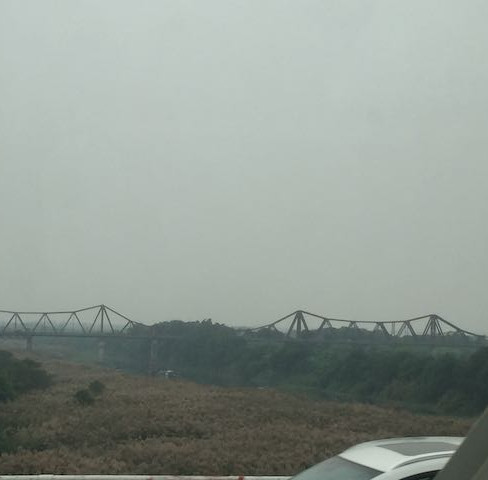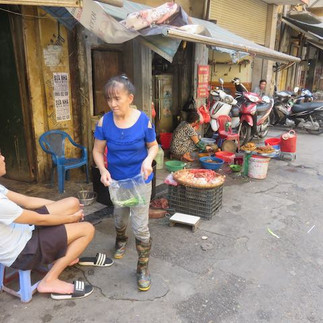October 21 to 23 and 25, 2019

Population (metropolis): 16.1 million
As soon as we got the immigration stamp in our passports, I felt home somehow. A feeling of walking in my ancestors’ footsteps on this land, under different conditions of course.
Let me give some background…
The Monges were in Indochina for 3 generations.
On my Dad's side, my grand-father’s grand-father (aka my great-great-grand-father) arrived in Saigon, Indochina circa 1862, at the beginning of the colony. 2 generations were born in Saigon including my grand-father Geo, his sisters and little brother Christian (who shares anecdotes, facts and stories with me). As I already said, my grand-father passed away before I was born but going to Kunming (same guy that walked 600 miles in the jungle) and to Vietnam make me feel closer to him.
On the Clavel side (still my Dad's), my grand-mother (Lilette)’s Dad (aka my great grand-father), originally from the center of France, had crossed the Atlantic and worked at the Plaza hotel in NYC around 1905-1910. Once WWI broke out, he headed back to France to defend his country. In the ‘30s, a bad hailstorm ruined his vineyard and promised a bad year. He went back to the military as an officer and got a job in the colonies. He was sent to Vinh, Indochina, 180 miles south-east of Hanoi. He left with his wife and kids. And that’s where my grand-mother and her siblings grew up.
In the ‘40s, my grand-parents met in Hanoi, most likely at university. My grand-father did a 1st year of Medical school (he later went to Law school) and my grand-mother studied Natural Sciences (to become a teacher). Back then, for a 20-year old female, studying away from home at university, was quite an achievement and ahead of her time!
Back to 2019...
To head to our apartment downtown, we experienced our 1st Grab (South-East Asian version of Uber). It is very convenient and prevents fake taxi scams (with faster meters for example). Once a car is booked, the license plate number of the driver is shared.
The vegetation in Vietnam looks familiar, similar to New Caledonia's: banana trees, coconut trees, flamboyants, frangipani , etc
The difference is in the traffic and the way of driving. The road is chaos: overcrowded 2-wheelers (for the family – including kids and babies – or cargo – animals, ladders, tubes, glass cabinet, …) going in all directions with very low signage and mostly without helmets. Honking is permanent - used both for passing or signal presence to others.
Once we settled in our Airbnb hostel, located in a small and quiet alley, we headed to the Dong Xuan market nearby. It was already dark (the sun sets down between 5:30 and 6pm here).
Dong Xuan market by day
That’s when we realized that sidewalks are actually used by 2-wheelers as parking lots or by street food stalls for their customer tables.

Street restaurant (very common in Vietnam)
But that’s only when we reached the main street north from our alley, that we realized how LOUD the traffic is here in Vietnam. A big contrast with China where most vehicles are electric so the cities are actually pretty quiet.
As the market was closing, we kept going, passed a pineapple seller (which smelt so good even at a distance), and ended up walking on Long Bien bridge, over the Red River (that we could not see by night as public lights were dim). It was fantastic, noisy and a little scary to feel the bridge moving and see the top handrail rusty to the point that it lost some smaller sections. It would have been impressive to be on the bridge while a train was going through but we did not have that chance and I think Salah was thankful for it 😩
Bubble of History : The Long Bien Bridge was designed by Gustave Eiffel (the Eiffel Tower guy) and built between 1899 and 1902. It was bombed on several occasions during the American War, and each time quickly repaired by the Vietnamese. Today, the bridge is used by trains, mopeds and pedestrians.
The Long Bien bridge by night and day, close up and far out
Infrastructure is generally in poor state in Hanoi. It is a shame because the city has a lot of historical sites that could be showcased. Some areas of the city are a mix of new and old.
Walks are sporty in Hanoi: zigzagging between parked scooters and restaurant tables on sidewalks that forces us to walk on the street, litter, shops. Streets are narrow and, with the girls, we are always on the watch for traffic so it’s not easy to appreciate the surroundings.
Crossing the street feels like being a kamikaze at the beginning. How can this continuous flow of vehicles be broken up with broken bones? But if we did not start crossing, we would still be in Hanoi so we learned to make our way, vigilantly but audaciously.
Streets in Hanoi
But we roamed around the Old Quarter, the historic district.
We saw the Hoan Kiem Lake, which was nice with the Huc red bridge over it.
Bubble of History : Legend claims in the mid-15th century Heaven sent Emperor Ly Thai To a magical sword, which he used to drive the Chinese from Vietnam. After the war a giant golden turtle grabbed the sword and disappeared into the depths of this lake to restore the sword to its divine owners, inspiring the name Ho Hoan Kiem (Lake of the Restored Sword). Excerpt From “Lonely Planet Vietnam.”
The Huc bridge and the Turtle tower
We also saw a Water Puppet Theatre show, which was really nice.
The art is close to 1,000 years old and originated in the Red River delta. The show takes place in a tank of waist-deep water. Traditional live music is as important as the action on stage. The show consists of a series of pastoral scenes and legends (like the legend of neighboring Hoan Kiem lake). One scene tells of the battle between a fisherman and his prey, which is so electric it is as if a live fish were being used. There are also fire-breathing dragons (complete with fireworks) and a flute-playing boy riding a buffalo.
Puppets are made of fig-tree wood and can last up to 4 months if continually used. They are 20'' high and can weight up to 33 lb. Involved in the show are 11 puppeteers immersed in the water too and 8 musicians and singers (on the dry side).
The girls loved it and us too! It was entertaining, original and amusing.
A half-mile away from the house, a speeding train passes twice a day only inches from the homes of this residential neighborhood. We went early enough to have premium spots (and were forewarned by locals to stay against the buildings) and waited. It was a thrill! Now that the place attracts a lot of tourists, they have policemen for safety. We still saw someone positioning a GoPro camera between the tracks. I am not sure what happened to the camera after the train!
What I loved about Hanoi, from the very beginning, was the coffee spirit of the city (and of the country, as we visited other places). Cafés everywhere, from the street cart to the Highlands Coffee chain (Starbucks is there too but they are very scarce), from popular to upscale… I just love it!

Cà Phê, Vietnamese for coffee
Too bad we did not get to enjoy an egg coffee in Hanoi where it was created. But we caught up to it in Hoi An! Made of coffee, sweetened condensed milk and whisked yolk, it looked more like a tiramisu than a drink, and it was delicious. Recipe here: https://www.legalnomads.com/vietnamese-egg-coffee-recipe/
Of course, we tried the local food: banh cuon (flat rice rolls stuffed with chopped pork and mushrooms) and nems (deep fried spring rolls) that I grew up with, being staples in New Caledonia (told ya, feels like home to me), banh mi (baguette with salad and meat, heritage from the French). It was awesome! After our trip to Pu Luong, we spent another night in Hanoi and tried the bun cha at the Huong Lien restaurant that hosted Obama and Anthony Bourdain in 2016. It consists of a soup with rice noodles, bbq pork, and fresh herbs and greens on the side, my favorite food in Hanoi! We ordered the Obama combo (you will have guessed that was the menu the former US President had for dinner): nems, bun cha and a Hanoi beer.
On the sweet side, we found the Marou chocolate factory and had to try! ☺️ They have chocolate bars and French-style pastries that were very tempting. That time, I only went with the chocolate bars (but see later that we did try more in HCMC) because it’s way overbudget. China and Vietnam don’t have big dessert cultures, especially not with chocolate (did not find Nutella in China), so it was auspicious to find this place. The chocolate bar was very OK😜
While there were many other places we could have visited in Hanoi, the noise, the pollution, the litter on the streets made us want to connect with Mother Nature. That’s exactly what we did in Pu Luong to visit rice paddies and in Cat Ba to see the Lan Ha bay, Ha Long bay’s sister.
Coralie


































































Comments